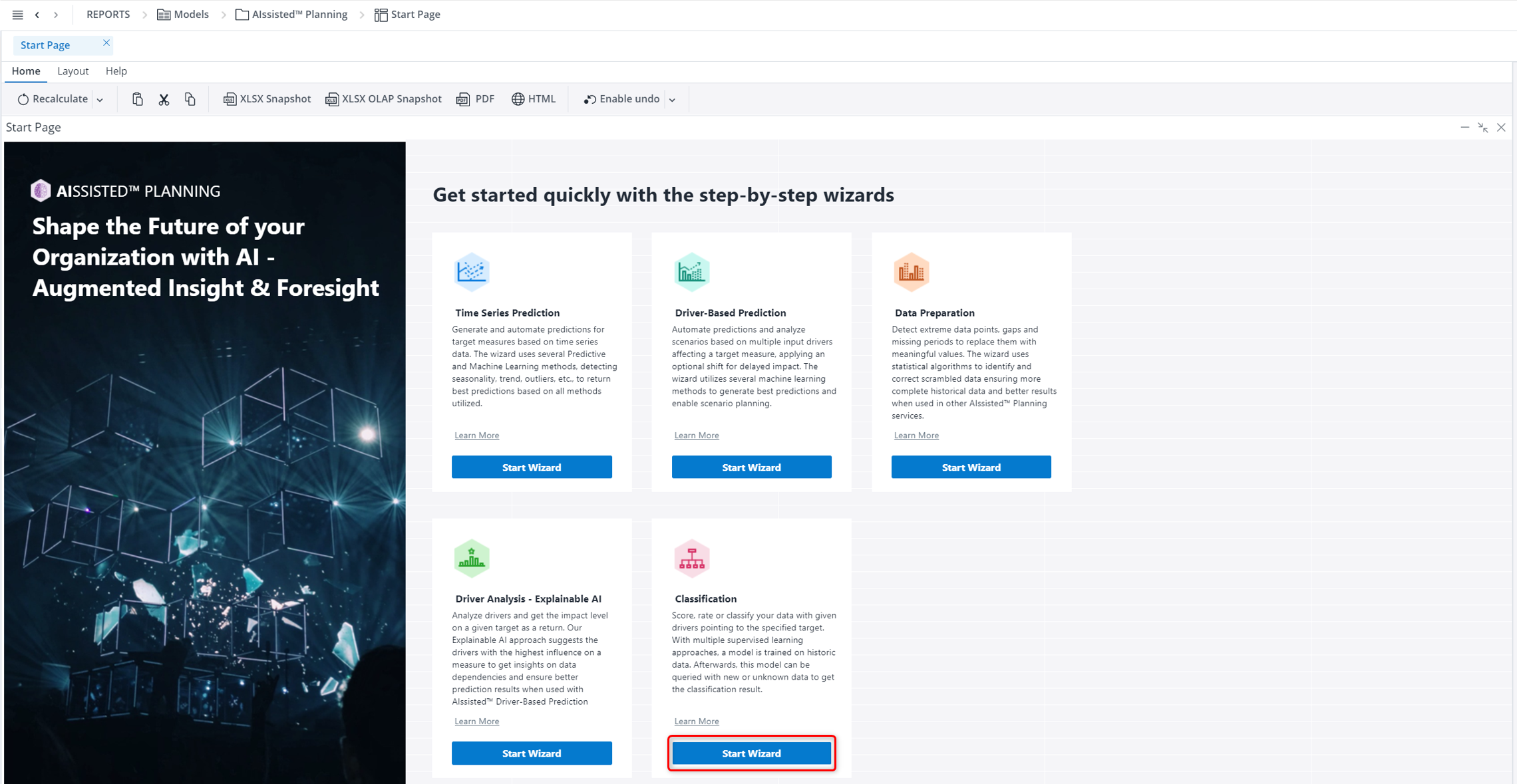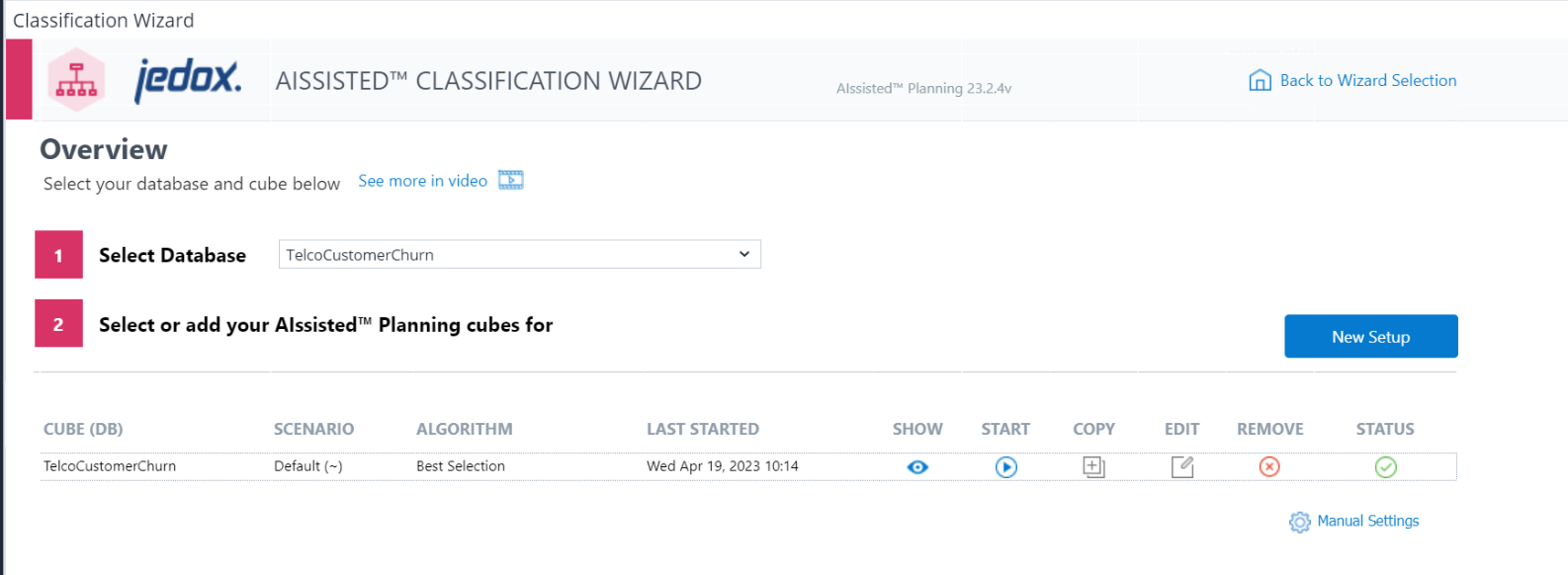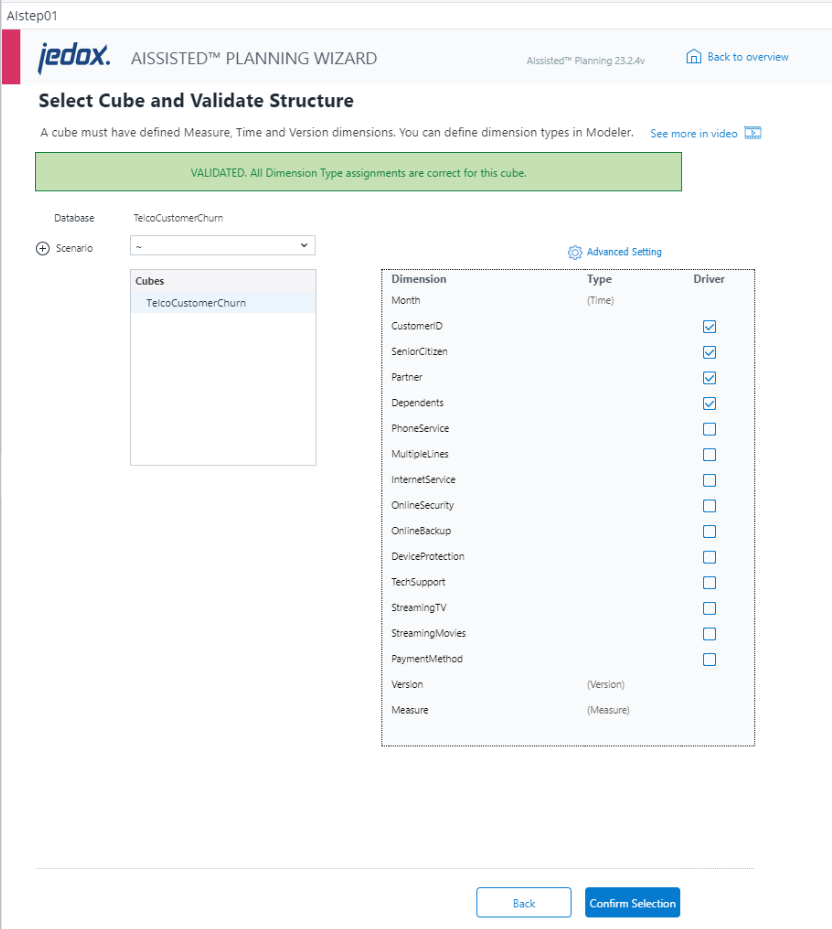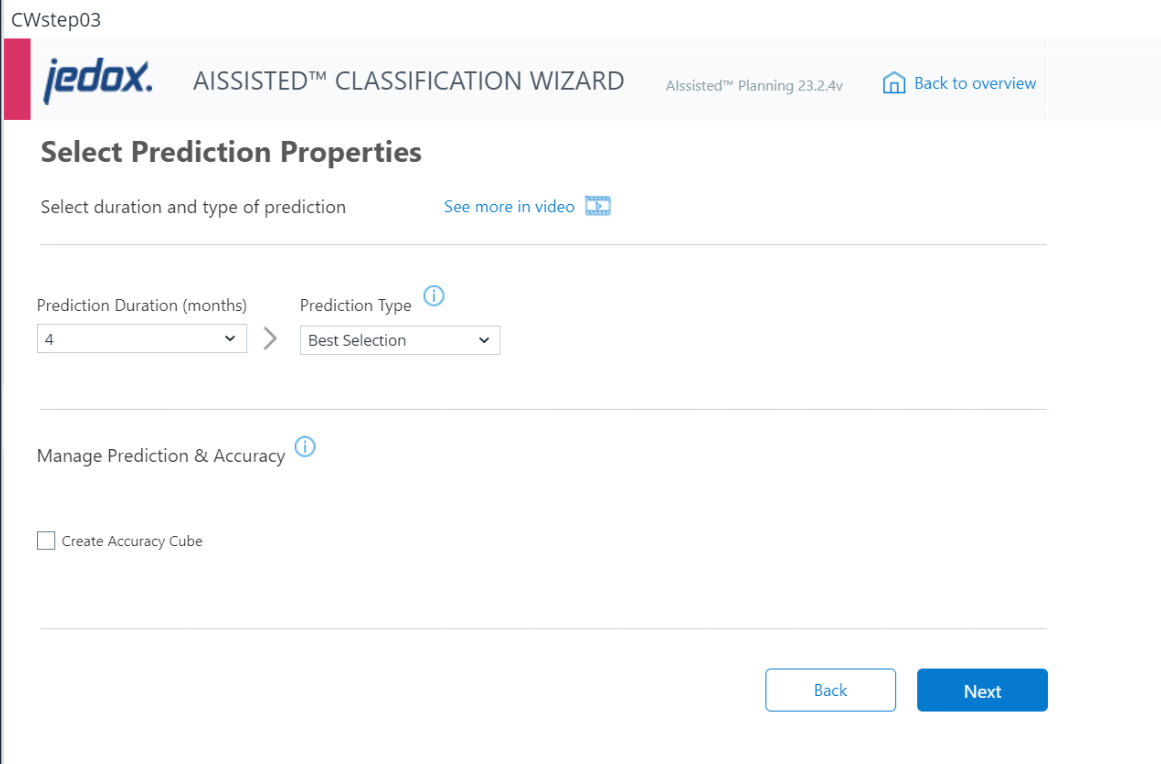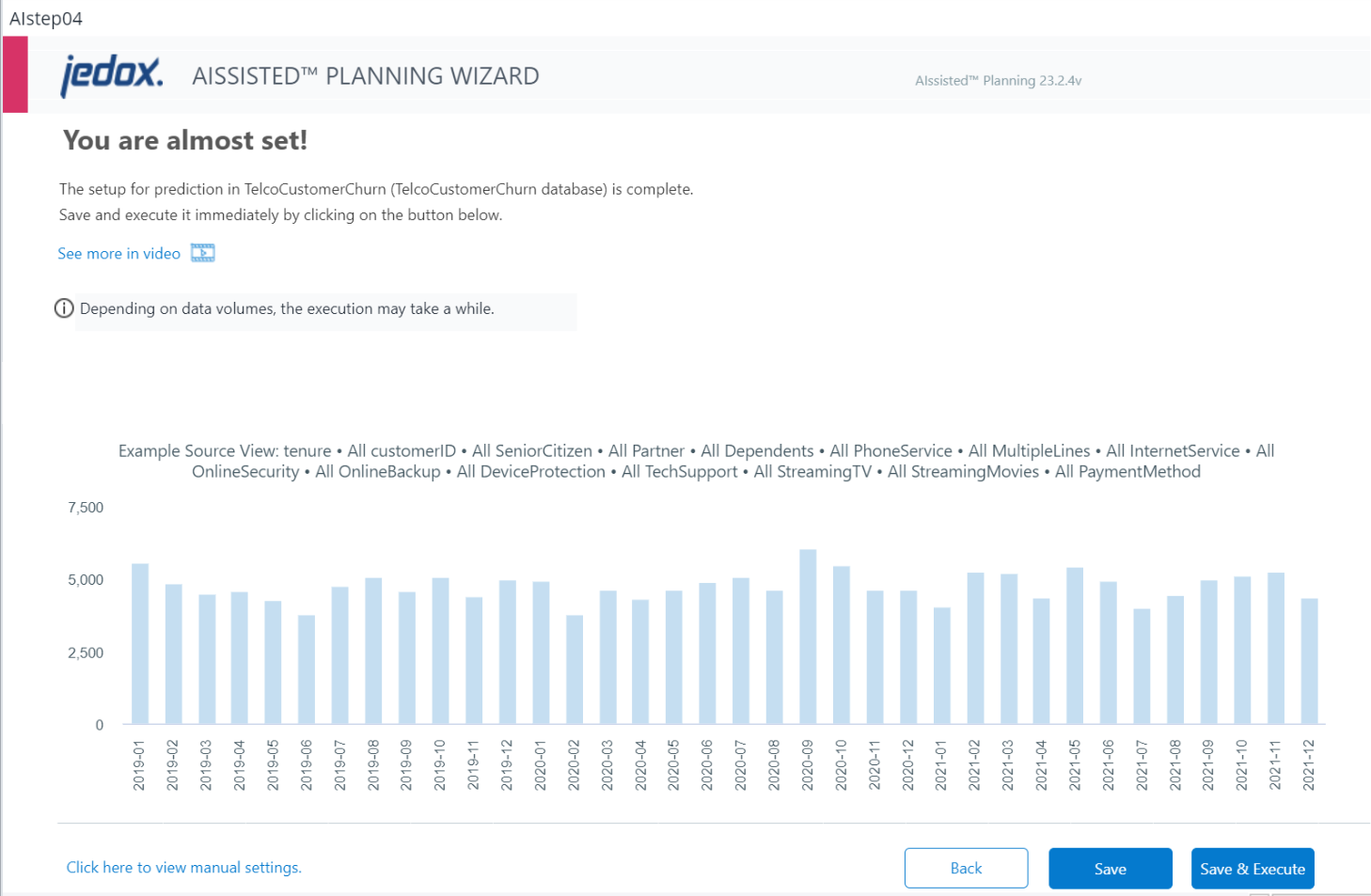The AIssisted™ Classification Wizard rates or classifies a target measure by using predefined drivers pointing to the specified target.
The wizard guides you through the simple, three-step process of integrating classification prediction technology to your custom work environment. Start by choosing the Classification Wizard from the Start Page. This will open the Classification Wizard Overview.
Classification Wizard Overview
The overview shows the scenarios for each database and cube equipped with a classification scenario. Choose the database and you will see the corresponding cubes, scenarios, and information relevant to each scenario.
On each wizard page, you will find videos and tutorials explaining each step and report.
The fields of the Classification Wizard Overview are described below:
| Field | Description |
| Select Database | A dropdown of all databases stored in your Jedox instance. The database is your native work environment populated with custom data. We also provide demo data to allow you to familiarize yourself with classification prediction functionality outside of your own work environment. |
| CUBE (DB) | The cube within the database selected that has the classification prediction scenario. You may choose any cube for classification prediction purposes, so long as it has at least three dimensions that the wizard can utilize as the Time, Version, and Measure dimensions. |
| SCENARIO | Shows the saved scenarios for each cube. This can be used to create different classification prediction setups for the same cube. |
| ALGORITHM | AIssisted™ Classification uses several different algorithms. Each calculates predictive output for your actual data in a unique way. The Best algorithm calculates all other algorithms and chooses the most accurate calculation. Alternatively, you can prescribe a specific algorithm (Random Forest, K Nearest Neighbors, etc.). |
| LAST STARTED | Shows the last time each cube's classification was started. |
| SHOW (button) | Shows the results report for the classification prediction. |
| START (button) | Runs classification prediction with the existing setup for your cube. |
| COPY (button) | Allows you to copy an existing scenario by selecting it from the list of the "Copy Scenario" dialog, or add a new scenario, which will then appear in the "Scenario" list for selection. Click the Save Changes button to confirm the task. |
| EDIT (button) | Allows you to adjust the input data of the cube (e.g. choose different dimensions/elements). |
| REMOVE (button) |
Removes the AIssisted™ classification scenario and/or prediction values for the cube. Removing only the setup will allow you to keep prediction values, while removing values will keep the setup intact. You may also remove both. Click Close in the window once you are finished. |
| STATUS (button) | Displays the status of the Integrator job after you start it. To see eventual changes, click the refresh icon in the "Status" column. Once finished, it will show a different icon with the results. Click on the icon for more information. |
| New Setup (button) | Adds a new AIssisted™ Planning Classification scenario for a cube. |
| Manual Settings (button) | Allows you to make changes to classification scenarios without entering the wizard itself. Read more about it in Manual Settings for AIssisted™ Planning. |
Click New Setup to make a predictive forecast setup. The wizard will guide you through the necessary steps.
The selected database is shown along with a dropdown menu of scenarios and a list of available cubes stored within the database.
The "Cubes" list allows you to choose the cube on which you would like to perform classification prediction. The selection will indicate with a green or red message box whether the selected cube is validated for the analysis, i.e., whether it has the required dimensions. A validated cube must have a Time dimension, a Version dimension, and a Measure dimension. Click the Advanced Setting button to access the dimension type assignments.
It is recommended to not use dimensions that contain special characters in their names (e.g. , / $), as these can cause problems when using the wizard.
Check the boxes of the drivers you want to use for your classification prediction under the "Drivers" column. It is recommended that you select at least two drivers for meaningful results.
The "Scenario" combobox gives you the option to save more than one scenario per cube. Select your scenario from the dropdown menu or click the + to open the "Create New Scenario" dialog. There you can add a new scenario, which will then appear in the "Scenario" list for selection. Click the Save Changes button to confirm the task.
Once you have selected a validated cube, click Confirm Selection, and then click Next.
You have selected your cube. Now you must choose the specific data slice the wizard will use to run the classification prediction.
The essential components of this slice are the Time, Version, and Measure dimensions.
The Set defaults button selects either the Default Read Element or the first element from each dimension (apart from Time, whose default elements are the first and last elements of the dimension). You may, of course, also select your source material manually.
Set the start and end dates of the source of your prediction. If your data is daily, the selection should be on that level, e.g. 2018-01-01. If it is monthly, selections should be on the monthly level, e.g. 2018-01. Note that elements with suffixes or prefixes should not be selected, as this will trigger an error.
Click the adjustment icons (![]() ) to set the rest of your source material, which can include multiple elements per dimension.
) to set the rest of your source material, which can include multiple elements per dimension.
The source Version contains the data on which the classification will be based. The prediction values are then stored in the Target Version. By default, a prediction element is created, you can select or add another target element by clicking +.
The source Measure dimension should include the drivers that contain data within the time range you want to predict. The Target Measure element is the one you want to classify. In other words, choose all the measure elements that should affect the measure element you are trying to classify.
The Other Dimensions will further fine-tune your prediction. The combination of the selected drivers is then used to predict the class of the target (Measure) element.
There are two options for the mode setting: onlyNodes and onlyBases. This sets whether the algorithms will use data at the consolidated (node) level or at the base level. For best results, set the data for all selected drivers at the base level, even if the mode is set to onlyNodes.
When analyzing data, onlyNodes uses exactly the elements you specified for the prediction. For example, if you specify "All Regions" in the Region dimension, a time series from the consolidated element "All Regions" is used as the source data. In contrast, using onlyBases causes the prediction to be calculated for each base element under the selected (consolidated) element. For example, if you select "All Regions" and under this consolidated element are the children Germany, Austria, and Switzerland, these three base level elements would then be used as the source data. The results are calculated for these three time series and then written back to these three time series. Since the inputs for the two methods are different, the resulting outputs would also be different.
Note that for the Attributes selection, only one dimension's attributes can be selected at a time. If a user has selected attributes for one dimension and then selects attributes from another dimension, the first selections will be deleted.
The Source View button allows you to view the source data before going through the classification process. After entering all your parameters, click on this button, and a preview window will pop up, showing how the source data looks.
If you are satisfied with the data, just close the "Preview Source" window. After you have selected your analysis source, click Next.
Now you must select the classification prediction properties, namely the duration and type.
You can select the monthly prediction duration between 1-24 months.
There are various prediction types, each with different algorithms. Simply hover over the info icon after selecting an algorithm for more information. The Best Selection prediction type runs all algorithms and selects the one that has the highest training accuracy.
The Accuracy cube checkbox displays the training accuracy of the prediction for the chosen algorithm. When Best Selection type is selected, the accuracy values for all algorithms are stored in the Accuracy cube and the algorithm with the highest training accuracy is chosen. This can be viewed in the results preview.
Click Back to edit the scenario or Next to move to the next step.
You may now save and execute the classification prediction or simply save your settings. Click Back if you wish to edit your previous selections. Your setup for this database will now appear in the Classification Prediction Overview. Here it can be viewed, modified, and executed at any future point.
Once executed, the data can be viewed by clicking the SHOW icon for the corresponding setup on the overview page.
Updated November 6, 2025
